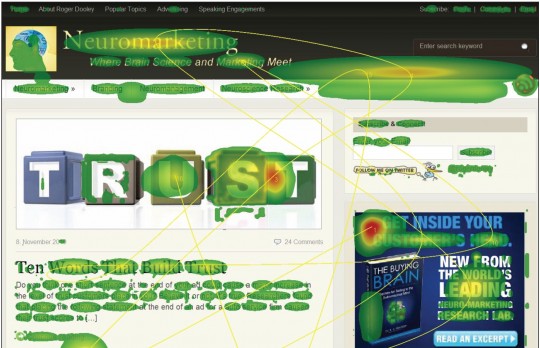Free Website Heat Map
Last week at Pubcon, I had the honor of sharing a “mini-keynote” session with landing page guru Tim Ash of SiteTuners. Tim mentioned an interesting heat map simulation tool from his company, AttentionWizard.
AttentionWizard is designed to simulate eye tracking heat maps at vastly lower expense. According to Tim, the heat maps produced by the tool match real eye tracking tests at better than 70%. The tool itself is based on an algorithm that looks at known eye-attracting factors (e.g., edges, colors) and the way people’s eyes typically scan a page.

For the heck of it, I ran a test on the Neuromarketing home page. The result, shown above, looks a little choppy – do people really scan all those little words? Nevertheless, that could be an indicator of distracting content, particularly if you are analyzing a landing page. (For non-Web marketers, a “landing page” is a page to which traffic is directed, usually from paid search ads, in order to convert the new visitor into a registration or a sale.) A key element of landing pages is a minimum number of distracting graphics, links that take the visitor off that page, etc., since elements like those get in the way of conversion.
Even simulated heat maps can identify issues like a distracting (and non-essential) graphic element or a “buy now” button that is too inconspicuous. In Tim’s book, Landing Page Optimization: The Definitive Guide to Testing and Tuning for Conversions, he notes,
“Eye-tracking is particularly useful in detecting problems in the earlier stages of the decision process (awareness and interest). If most test subjects do not look at the desired part of the page, they are not even aware that the conversion action is possible. In effect, for similar visitors to your site the conversion action does not exist.”
While in that context Tim is referring to real eye-tracking tests, similar logic would apply to simulations that are reasonably representative of the real thing.
Free Heat Map
Although AttentionWizard is a paid service, it allows one free heat map to be generated per day. The paid versions produce higher resolution images, faster results, and have either a small watermark or no watermark at all.
Give the tool a try and let me know if it matches up with your experience. In particular, if you have tried multiple page versions it would be interesting to see if this simulated heat map predicts issues correctly. Feel free to post a comment with your experience or opinion!
